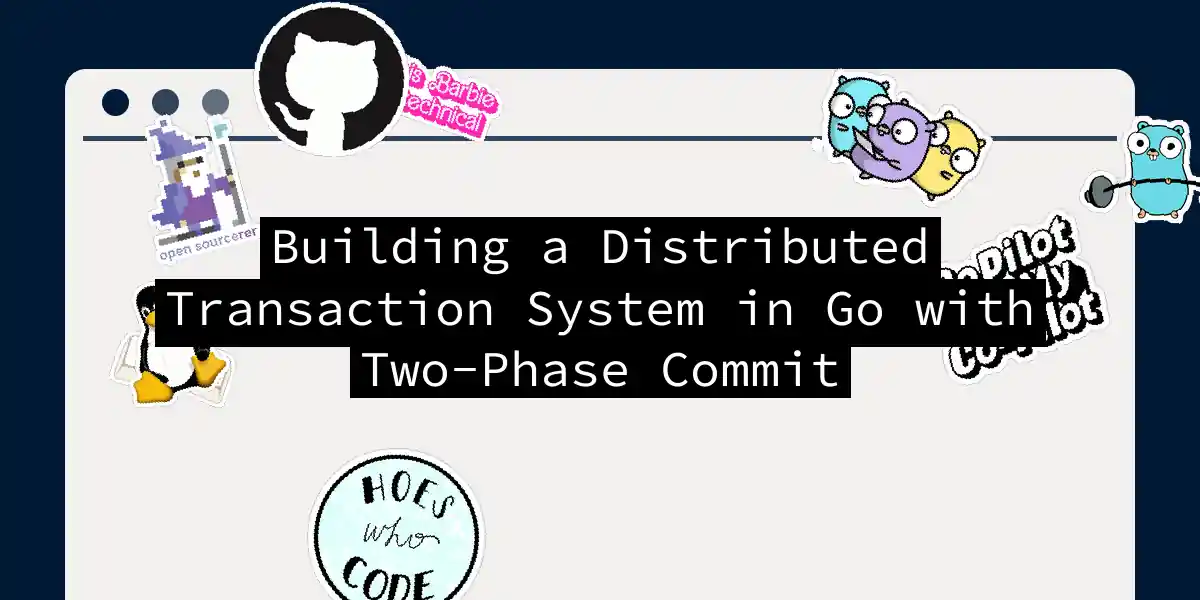Introduction to Distributed Transactions
When working with microservices, ensuring data consistency across multiple services can be a daunting task. Distributed transactions are a way to manage this complexity, but they come with their own set of challenges. In this article, we’ll delve into the world of distributed transactions, specifically focusing on the two-phase commit (2PC) mechanism in Go.
Why Distributed Transactions?
In a microservice architecture, each service might have its own database or storage system. When a transaction involves multiple services, ensuring that either all changes are committed or none are, is crucial for maintaining data consistency. For example, in an e-commerce application, when a user places an order, the system needs to update both the user’s account and the order database. If one update fails, the other should be rolled back to maintain consistency[1][3].
Two-Phase Commit (2PC)
The two-phase commit is a protocol designed to ensure atomicity in distributed transactions. Here’s a high-level overview of how it works:
Phase 1: Prepare
In the prepare phase, each participant (service) is asked to prepare for the transaction. If any participant fails to prepare, the transaction is aborted.
Phase 2: Commit or Rollback
If all participants successfully prepare, the transaction coordinator sends a commit message. If any participant fails during the prepare phase, a rollback message is sent.
Implementing 2PC in Go
To implement 2PC in Go, we can use the DTM (Distributed Transaction Manager) framework, which provides a robust way to handle distributed transactions.
Setting Up DTM
First, you need to set up the DTM framework. Here’s how you can do it:
git clone https://github.com/dtm-labs/dtm && cd dtm
go run main.go
Basic Example
Let’s consider a simple example of transferring funds between two accounts. We’ll have two services: TransOut and TransIn.
Database Schema
CREATE TABLE IF NOT EXISTS user_account (
id INT(11) PRIMARY KEY AUTO_INCREMENT,
user_id INT(11) UNIQUE,
balance DECIMAL(10, 2) NOT NULL DEFAULT '0',
trading_balance DECIMAL(10, 2) NOT NULL DEFAULT '0',
create_time DATETIME DEFAULT NOW(),
update_time DATETIME DEFAULT NOW(),
KEY(create_time),
KEY(update_time)
);
Try/Confirm/Cancel Handlers
In the 2PC context, we need to define Try, Confirm, and Cancel handlers for each service.
func transOutTry(ctx context.Context, req *busi.BusiReq) (interface{}, error) {
// Freeze the amount in the sender's account
sql := "UPDATE user_account SET trading_balance = trading_balance + ? WHERE user_id = ? AND balance + trading_balance >= 0"
_, err := db.Exec(sql, req.Amount, req.UserID)
if err != nil {
return nil, err
}
return nil, nil
}
func transOutConfirm(ctx context.Context, req *busi.BusiReq) (interface{}, error) {
// Commit the transaction by moving the frozen amount to the recipient
sql := "UPDATE user_account SET balance = balance - ?, trading_balance = trading_balance - ? WHERE user_id = ?"
_, err := db.Exec(sql, req.Amount, req.Amount, req.UserID)
if err != nil {
return nil, err
}
return nil, nil
}
func transOutCancel(ctx context.Context, req *busi.BusiReq) (interface{}, error) {
// Rollback the transaction by unfreezing the amount
sql := "UPDATE user_account SET trading_balance = trading_balance - ? WHERE user_id = ?"
_, err := db.Exec(sql, req.Amount, req.UserID)
if err != nil {
return nil, err
}
return nil, nil
}
// Similar handlers for TransIn service
Creating the 2PC Transaction
func main() {
// Create a new transaction
trans, err := dtmcli.NewTrans(dtmcli.MustGenGid(), dtmcli.DefaultConf, "transOut", "transIn")
if err != nil {
log.Fatal(err)
}
// Add branches for each service
trans.AddBranch(&dtmcli.Branch{
Op: "transOutTry",
Target: "http://trans-out-service/try",
})
trans.AddBranch(&dtmcli.Branch{
Op: "transInTry",
Target: "http://trans-in-service/try",
})
trans.AddBranch(&dtmcli.Branch{
Op: "transOutConfirm",
Target: "http://trans-out-service/confirm",
})
trans.AddBranch(&dtmcli.Branch{
Op: "transInConfirm",
Target: "http://trans-in-service/confirm",
})
trans.AddBranch(&dtmcli.Branch{
Op: "transOutCancel",
Target: "http://trans-out-service/cancel",
})
trans.AddBranch(&dtmcli.Branch{
Op: "transInCancel",
Target: "http://trans-in-service/cancel",
})
// Start the transaction
err = trans.Submit()
if err != nil {
log.Fatal(err)
}
}
Handling Network Exceptions
One of the critical aspects of distributed transactions is handling network exceptions. DTM provides a BranchBarrier utility to ensure idempotency and handle network failures.
func (bb *BranchBarrier) Call(tx *sql.Tx, busiCall BarrierBusiFunc) error {
// This ensures the operation inside this function will be called at most once
return busiCall(tx)
}
Rollback Mechanism
If any part of the transaction fails, DTM will automatically invoke the cancel operations to roll back the transaction.
Best Practices and Alternatives
Avoiding Distributed Transactions When Possible
While distributed transactions are powerful, they can add significant complexity to your system. If possible, it’s better to avoid them by ensuring that your microservice boundaries are correctly defined and that each service manages its own consistency[1].
Embracing Eventual Consistency
In some cases, eventual consistency can be a simpler and more scalable solution. This involves using message queues and event sourcing to ensure that data is eventually consistent across services[1].
Using the Outbox Pattern
The outbox pattern is another approach to ensure consistency. It involves storing events in the same database transaction as the main data and then publishing these events asynchronously. This ensures that the event and the stored data are always consistent[1].
Conclusion
Distributed transactions are a complex but necessary aspect of microservice architecture. By using frameworks like DTM and following best practices such as handling network exceptions and considering alternatives like eventual consistency and the outbox pattern, you can ensure that your system maintains data consistency across multiple services.
Remember, distributed transactions are not a silver bullet, but with the right tools and mindset, they can be a powerful tool in your arsenal for building robust and scalable systems. So, the next time you’re faced with the challenge of managing data across multiple services, take a deep breath, grab your favorite coffee, and dive into the world of distributed transactions with confidence.
